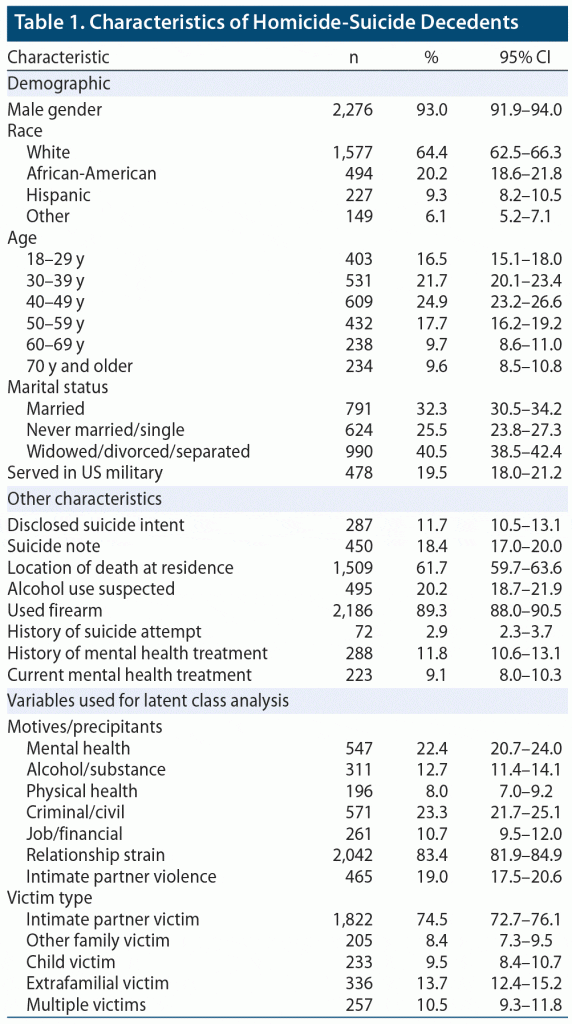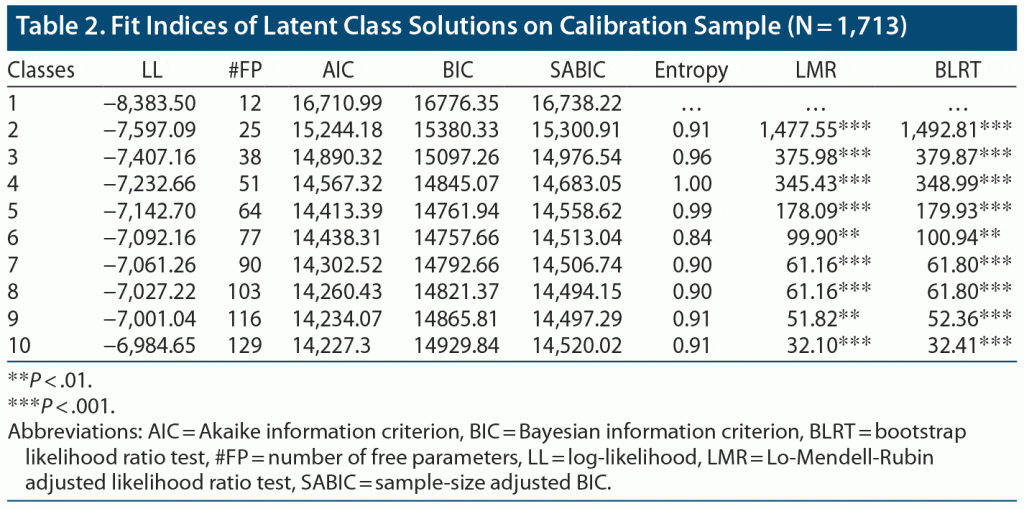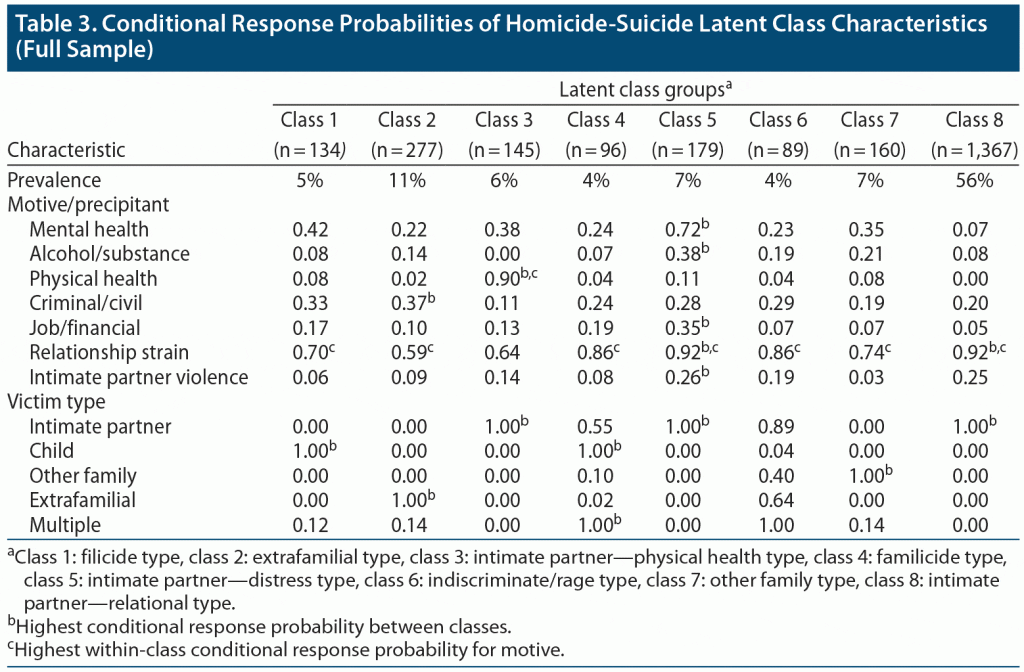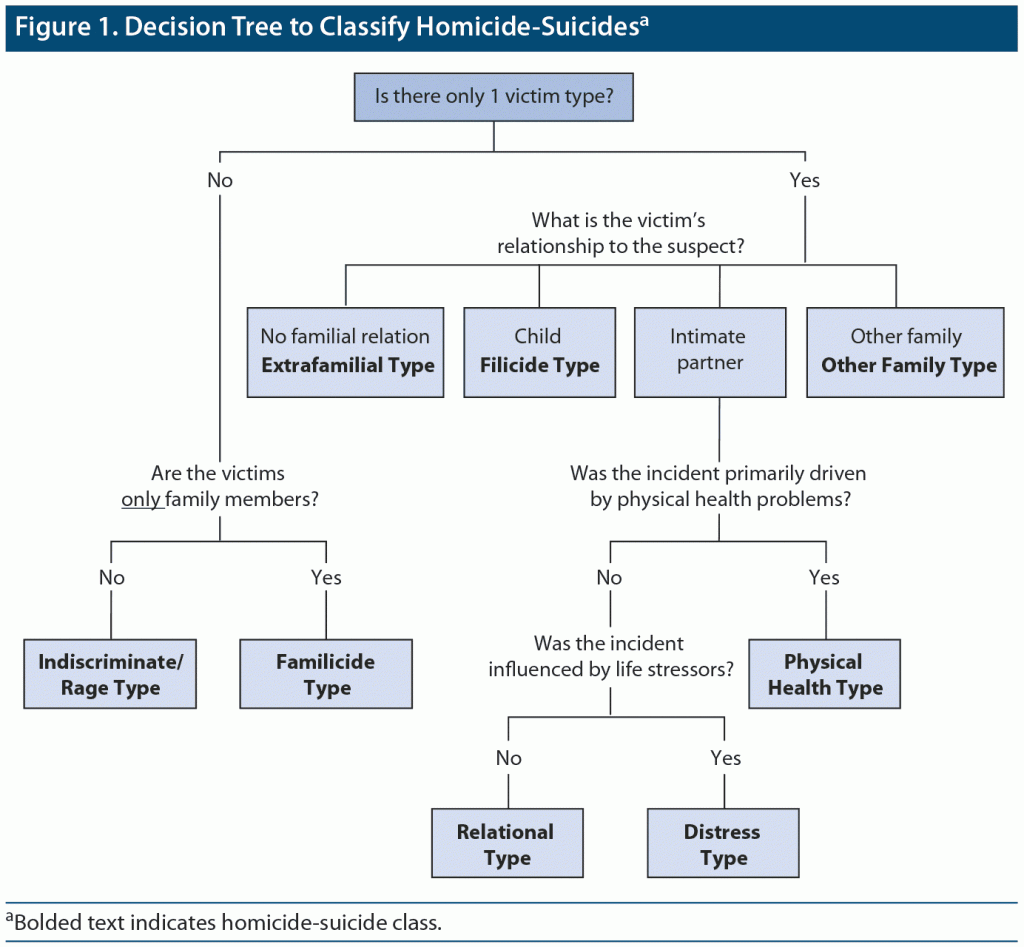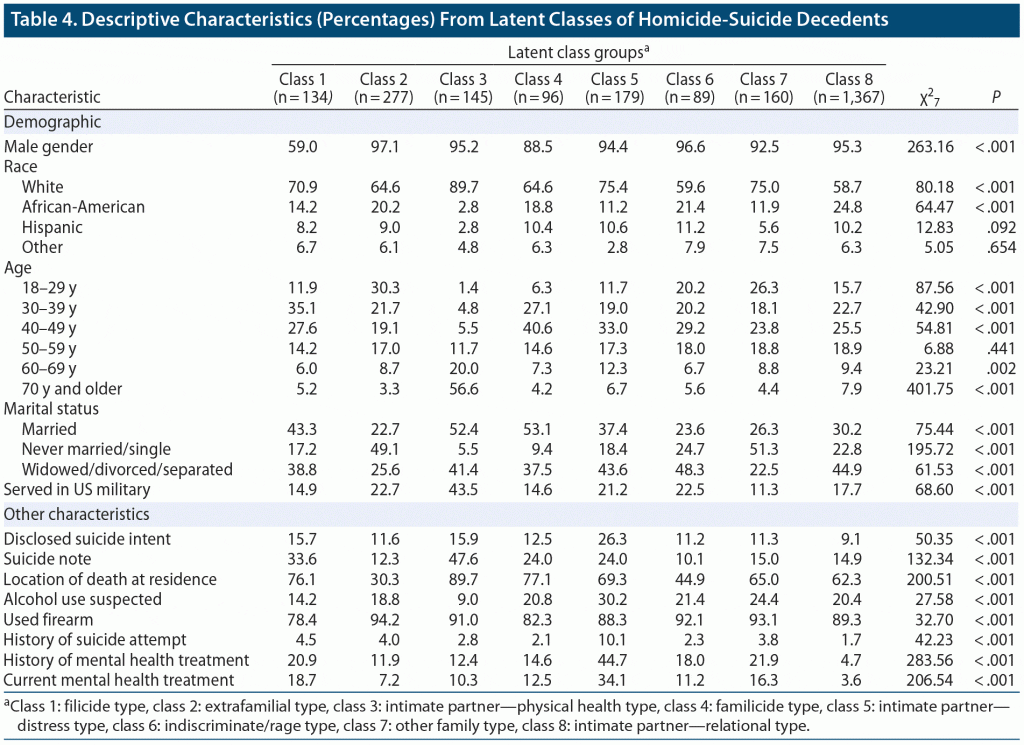
ABSTRACT
Objective: Homicide-suicide is an extremely heterogeneous and rare form of lethal violence. In an effort to capture this heterogeneity to enhance research and prevention efforts, typologies have been developed from literature reviews or geographically limited samples. The purpose of the present study was to develop the first empirically derived typology of homicide-suicide decedents, using a large, geographically diverse sample.
Methods: Data were used from the Centers for Disease Control and Prevention’s National Violent Death Reporting System from 2003 to 2015 across 27 states. Homicide-suicide decedents were included if they were ≥ 18 years of age, they were the only victim and suspect involved, they had a known relationship with the victim(s), and the circumstances surrounding the event were known. There were 2,447 decedents that met study criteria. Unsupervised machine learning was used to classify decedents by precipitating circumstances and victim types.
Results: Eight homicide-suicide subtypes were identified and cross-validated in a holdout sample. Three subtypes consisted of only intimate partner victims, 3 subtypes had a single victim type (children, extrafamilial, other family), and there were 2 multivictim subtypes: one that could be identified as familicide and the other in which there was indiscriminate killing, which often included an intimate partner. Subtypes were distinguishable by demographic and other characteristics (median area under the curve = 0.77). Relationship problems precipitated 60%–92% of homicide-suicides across subtypes, while mental health problems were recognized as a precipitant in 7%–72% of decedents across subtypes.
Conclusions: The findings expand upon and validate previously proposed homicide-suicide typologies. While relationship problems are common precipitants across homicide-suicide subtypes, known mental health problems vary across subtypes.
J Clin Psychiatry 2021;82(2):20m13528
To cite: Jordan JT, McNiel DE. Homicide-suicide in the United States: moving toward an empirically derived typology. J Clin Psychiatry. 2021;82(2):20m13528.
To share: https://doi.org/10.4088/JCP.20m13528
© Copyright 2021 Physicians Postgraduate Press, Inc.
aDepartment of Psychology, Dominican University of California, San Rafael, California
bDepartment of Psychiatry and Behavioral Sciences, University of California, San Francisco, California
*Corresponding author: Joshua T. Jordan, PhD, Department of Psychology, Dominican University of California, 50 Acacia Ave, San Rafael, CA 94901
([email protected]).
Homicide-suicide is a devastating incident in which an individual takes the life of 1 or several persons and then dies by suicide. Although these events account for 1,000–1,500 deaths in the United States annually1—far fewer than homicide- or suicide-only deaths—they receive widespread attention from the media, have a lasting impact on communities,2 and can perpetuate ill-informed perceptions of violence and mental illness.3,4 Given the difficulty in collecting detailed information on decedents, and the rarity of homicide-suicide, empirical research is limited2 to small, geographically restricted samples. Little progress has been made in understanding this phenomenon.5
Homicide-suicide is markedly heterogeneous, as victim(s) and precipitants/motives vary substantially from case to case (eg, “act of mercy” with chronic/debilitating illness vs homicide of a spouse threatening separation/divorce). Understanding heterogeneity in homicide-suicide is critical in efforts for targeted prevention. Several typologies have been proposed to capture this heterogeneity6–10 and focus on the decedent’s relationship to the victim(s) and the precipitant stressor, while one focuses on the underlying motivation for the incident.10 Most typologies7–9 extend the work by Marzuk et al,6 who identified 5 primary subtypes: “amorous jealousy” (intimate partner victim, triggered by breakdown of a romantic relationship), “declining health” (intimate partner victim or the decedent in poor health), “filicide-suicide” (child victim), “familicide-suicide” (members of family), and “extrafamilial” (individuals who are not intimate partners or family members). Cases do not always fit into existing typologies,7 perhaps due to the fact that they have been derived from anecdotal evidence or subjective examination of patterns in data limited by geographical region and/or sample size. Development of typologies empirically from large datasets has been recommended as best practice11,12 but has not been applied to homicide-suicide.
The purpose of this study was to overcome some limitations of previous efforts by (1) characterizing homicide-suicide decedents with a large-scale database more nationally representative than previous studies and (2) developing and characterizing the first empirically derived typology for homicide-suicide decedents in the United States, using unsupervised machine learning.
METHODS
Data Source and Case Selection
The present study used data from the Centers for Disease Control and Prevention (CDC) National Violent Death Reporting System (NVDRS) Restricted Access Database (RAD), a state-based surveillance system that collects details on violent deaths across the US. All data sources in the NVDRS are linked by incident, which permits identification of homicide-suicides. This study used NVDRS data from 2003 to 2015, which included 27 states. Information regarding the states and when they started contributing data can be found in Supplementary Appendix 1. Data were coded based on a standardized manual and entered by trained abstractors, based on information about precipitants/motives collected through death certificates and law enforcement and/or medical examiner/coroner reports.13,14 Homicide-suicide decedents were identified if they were marked as “both victim and suspect” by abstractors and as being a homicide-suicide case per the “HomiSui” variable, defined as an incident in which homicide(s) occurred within 24 hours of a suicide.15 Cases were included if (a) they were ≥ 18 years of age, (b) they were the only victim and suspect involved, (c) they had a known relationship with the victim(s), and (d) there was a known precipitant/motive.
This study was considered exempt from institutional review board approval as all cases were unidentifiable decedents. The RAD was obtained from the CDC following their approval of the study.
Variables
All variables measured for the present study were coded as dichotomous (0 = absent or unknown, 1 = present).
Demographic and other characteristics. Demographic characteristics included gender, race, age group, marital status, and military service. Other characteristics included current or past mental health treatment, suicide attempt history, and suicide-related characteristics (disclosed intent, presence of note, location of death, if alcohol use was suspected, and firearm vs other method).
Motives/precipitants and characteristics. These included mental health problems (either current mental health problem or perceived depressed mood around the time of the incident), alcohol and/or substance use problems, physical health problems (terminal disease or debilitating condition, coded as present in this study if it was present for the homicide-suicide decedent or for the victim), criminal/civil/legal problems, work/financial problems, relationship problems (coded as present for intimate partner problems, family relationship problems, or other relationship problems), and recent intimate partner violence. The latter variable was the only variable in the NVDRS that could appropriately assess history of violence, as other markers of violence are automatically coded as present for decedents.
Victim-decedent relationships. This was defined using the classification system by Logan and colleagues.16 Victims were considered an intimate partner if they were a spouse, former spouse, girlfriend or boyfriend, or former girlfriend or boyfriend. Victims were classified as “children” if they were the child/stepchild/foster child of the decedent and as “other family” if the victim had some other familial relationship (ie, parents, siblings, grandparents or grandchildren, in-laws, stepparents, children or parents of the decedent’s intimate partner, foster parent, or other family member). Finally, victims were “extrafamilial” if they were not related in any capacity to the decedent (ie, acquaintances, friends, roommates or schoolmates, strangers).
Data Analysis
Frequencies and proportions were calculated to characterize the sample. Empirically derived subtypes of homicide-suicide decedents were determined via mixture models, a form of unsupervised machine learning that identifies homogeneous subgroups. This approach was chosen over other clustering techniques because it relies on person-based probabilities instead of distance or ad hoc procedures to create classes11 and because it has been shown to outperform other techniques in recovering the true number of classes.17 Mixture models detect similar groups of individuals based on patterns of characteristics. For binary data, this type of mixture model is known as latent class analysis (LCA).18 A series of 1 to 10 class solutions was estimated via Mplus version 8.1 with robust maximum likelihood.19 The final number of classes was based on statistical fit indices, how well classes were separate from one another, and solution interpretability.18 Details on statistical fit indices used are in Supplementary Appendix 2. Split-sample cross-validation was used. Models were calibrated/trained on 70% of decedents (selected randomly), and the candidate solution was tested on the remaining 30% decedents (validation sample). A likelihood ratio test (LRT) was used in the validation sample, where a freely estimated k-class model was compared to a model forced to use the parameter estimates derived from the calibration/training sample (using the same number of k classes). A nonsignificant LRT (defined as P > .05) indicates that parameter estimates from the calibration sample do not significantly differ from the validation sample and that the candidate model is supported.18 Because the LRT is sensitive to negligible misfit,18 Kendall’s W was also used to estimate concordance between the calibration sample and the (freely estimated) validation sample.
Consistent with prior typologies, the LCA included motives/precipitants (current mental health problem or depressed mood, alcohol/substance problems, physical health problems of the victim or decedent, criminal/civil legal problems, job/financial problems, relationship problems, intimate partner violence), victim types (intimate partner, child, other family members, extrafamilial), and number of victims (single vs multiple). Information regarding how solutions were evaluated is included in Supplementary Appendix 2. Once an optimal solution was identified and supported in the validation sample, observations were classified into their most likely class membership based on their modal posterior probability.
External validation of subtypes. Lasso logistic regressions20 with 10-fold cross-validation and synthetic samples21,22 were employed to identify salient features and characteristics of subtypes. Features/characteristics included gender, age, race/ethnicity, marital status, veteran status, disclosure of suicide intent, presence of suicide note, suicide at residence, suspected alcohol use, suicide by firearm, suicide attempt history, and past/current mental health treatment. A one-vs-rest method was used, where one subtype was compared to all other subtypes on the aforementioned demographic and other characteristics. Further details can be found in Supplementary Appendix 3.
Analyses with the exception of the LCA were conducted in Stata v16.023 and R.24,25
RESULTS
General Characteristics
From 2003 to 2015, 2,572 homicide-suicide cases were recorded in the NVDRS; 2,447 (95.1%) met study criteria. Table 1 shows sample characteristics. Consistent with prior research, nearly all decedents were male and used a firearm,8,16,26,27 and most incidents involved an intimate partner.6 Approximately 90% of homicide-suicides consisted of 1 victim. Nearly two-thirds of decedents were Caucasian, the plurality were widowed/separated/divorced, and nearly half were 30–49 years of age. Only 12% disclosed intent to others, and 12% had a history of mental health treatment. Nearly 85% were experiencing or motivated by relationship problems, while less than 25% were identified as having a mental health problem around the time of the event. Nearly 25% had criminal/civil legal problems. Approximately 20% had recently perpetrated violence against an intimate partner.
Model Selection
Table 2 shows results of the LCA. Nearly all statistical indices favored the k + 1 solution. An examination of elbow plots28 indicated 4, 5, 6, or 8 classes were candidate solutions. The 8-class solution was most interpretable and chosen as the final solution. This solution was supported in the validation sample (χ2103 = 109.72, P = .307), and concordance between the calibration and freely estimated validation sample was high (Kendall’s W = 0.92). This solution was therefore applied to the full sample. Classes were well separated/classified (entropy = 0.90, average posterior probabilities ≥ 0.7829). Conditional response probabilities for the total sample are in Table 3; a decision tree to classify homicide-suicides is shown in Figure 1.
Validation of Subtypes
Class characteristics can be found in Table 4. Median cross-validated area under the curve from lassos was 0.77 (range, 0.68–0.91), suggesting that demographic and other characteristics distinguish individual homicide-suicide classes from the others reasonably well (see Supplementary Table 1). Interpretation of subtypes is provided in the following paragraphs in descending order (largest to smallest). Salient characteristics via lassos are mentioned; model coefficients are in Supplementary Table 1.
Homicide-Suicide Types
Intimate partner—relational (54%–58%). Nearly all decedents had relationship problems. This group had one of the highest rates of relationship strain and lowest prevalence of a known mental health problem/depressed mood. They were more likely to have a recent history of intimate partner violence. There was a higher proportion of African Americans in this group. Decedents were more likely to be widowed/divorced/separated and 50–59 years old, less likely to disclose intent/leave a note, and unlikely to have a history of mental health treatment. “Jealousy” was noted in 10% of these cases.
Extrafamilial (10%–13%). Victims were acquaintances/strangers only. This class had the highest rate of criminal/civil legal problems and lowest prevalence of relationship problems. Some of these cases consisted of incidents in which a homicide suspect was pulled over by law enforcement/when they were approached for an arrest, and around 20% were incidents in which an individual killed a current/former partner of their romantic interest. They were more likely to be male, Caucasian, unmarried, and 18–29 years old; to have served in the military; to use firearms; and to die outside their residence. They were less likely to disclose intent. While more likely to have a history of mental health treatment, they were less likely to receive it before the incident.
Intimate partner—distress (6%–8%). These decedents were characterized by other stressors in addition to relationship problems, including mental health, job/financial, alcohol/substances, and criminal/civil legal problems. They were more likely to be male, Caucasian, and in their forties; to have a history of mental health treatment; to disclose intent; to die in their residence; and to be suspected of having used alcohol at the time of the incident.
Other family (6%–8%). These decedents had a higher prevalence of a known mental health problem/depressed mood and/or an alcohol/substance problem. They were more likely to be Caucasian, in their forties, and single/never married; to have a history of mental health treatment; and to use a firearm.
Intimate partner—physical health (5%–7%). These cases occurred in the context of physical health problems (either the decedent or the victim—exclusively an intimate partner). They were more likely to have a mental health problem/depressed mood and less likely to have a relationship problem. They were more likely to be male, Caucasian, over 50 years old, and married; to leave a note; and to die in their residence.
Filicide (5%–6%). In these cases, decedents only killed their child(ren). They were more likely to have a mental health problem and/or depressed mood and have criminal/civil legal problems, perhaps indicative of custody disputes. Decedents were more likely to be female, Caucasian, in their thirties, and married. They were more likely to leave a note, die in their residence, and use means other than a firearm. Approximately 10% of these cases among female decedents included an infant victim, perhaps indicative of postpartum disorders.
Familicide (3%–5%). In this subtype, there were always multiple victims, and a child was always among them. Approximately half included an intimate partner, 10% consisted of other family members, and extrafamilial victims were loosely related in a familial capacity (eg, former in-law). This incident was more likely to occur in the context of job/financial problems. They were more likely to be male, 30–49 years old, and married and to have died in their residence.
Indiscriminate/rage (3%–4%). This subtype involves multiple victims and almost always an intimate partner. These cases included love triangles (30% of these cases), circumstances in which the victim was a current/former intimate partner and there was a friend or bystander at the scene, and fits of rage. Decedents were more likely to be male and widowed/divorced/separated and to have a history of mental health treatment. They were less likely to have left a note or to die in their residence.
DISCUSSION
This study used a large, geographically diverse database to develop the first empirically derived typology of homicide-suicides in the United States. Unsupervised learning identified 8 subtypes that were predicted by demographic and other characteristics. These subtypes support components of proposed typologies,6–9 as there was evidence for subtypes of intimate partner (relational or physical health), filicide, extrafamilial, and familicide homicide-suicides. It also identified additional primary subtypes as well (“intimate partner– distress,” “indiscriminate rage,” “other family”).
This study highlights aspects of homicide-suicide and its subtypes that may serve as points for prevention. First, red flag laws may be helpful in reducing firearm deaths30 and may be promising in the reduction of homicide-suicides, as over 80% of cases were precipitated by interpersonal problems. Such laws may be prudent with recent domestic violence, given its modest prevalence in some types of homicide-suicide, as well as in cases of (perceived) infidelity, or when a former romantic partner has a new partner. Safe storage practices may reduce suicides31 and are particularly relevant to homicide-suicide, as firearms were used in nearly all of these incidents. Additionally, although the aim of this study was not to identify which individuals will engage in homicide-suicide, it does point toward clinical/demographic profiles that are associated with specific types of homicide-suicide.
This study contributes foundational information important to understanding homicide-suicide. By elucidating an empirical classification of the patterns of demographic, contextual, and behavioral dimensions that characterize subtypes of homicide-suicide, these results can inform future efforts to better understand this complex phenomenon. An example of one promising dimension is to explore how psychopathology contributes to homicide-suicide. This investigation observed significant variability in the prevalence of known mental health problems among homicide-suicide subtypes, which may account for the considerable heterogeneity in prevalence estimates of psychopathology in homicide-suicide overall.32 It has been argued that all homicide-suicides are driven by psychopathology,10 as virtually all suicide decedents have some form of psychopathology.33,34 Appreciation for the types of psychopathology among homicide-suicide subtypes may allow for a nuanced understanding of which individuals may engage in this type of act. Furthermore, given that many homicide-suicide decedents have unrecognized psychopathology, this also raises the possibility that recently proposed diagnoses, such as acute suicidal affective disturbance35—characterized by a time-limited drastic increase in suicidal intent, social/self-alienation, hopelessness, and overarousal—may facilitate efforts at early detection and intervention with individuals at elevated risk.
This study has several limitations. Information coded by abstractors was based on law enforcement and/or medical examiner reports, and not reports from trained mental health professionals; some characteristics may be coded as “absent/unknown” when in fact the characteristic (eg, psychiatric) was present. Furthermore, it is unclear which informants were used to obtain information on the decedent and how well these informants were able to provide pertinent information. This is a common shortcoming in homicide-suicide studies, however, as optimal informants (eg, intimate partners) tend to be one of the victims. Psychological autopsy studies are therefore a promising next step in understanding homicide-suicide,7,36 as are studies that focus on survivors of attempted homicide-suicide.37 Although our study used a more nationally representative sample of homicide-suicide in the US than previous studies, not all states contributed data to the NVDRS, nor did all states contribute data for each year examined. It is also unknown how these subtypes generalize to other countries. The NVDRS uses strict criteria for homicide-suicide in which the suicide must have occurred within 24 hours of the homicide. It is unclear how subtypes may translate with different definitions. Although this study focused on known precipitants/motives, it is possible that there are other drivers of homicide-suicide that are unknown in the literature or were not addressed adequately in the NVDRS that may affect machine learning solutions (eg, personality characteristics). Replication of the subtypes will be of particular importance in future research, as some of the class sizes were relatively small.
There are multiple strengths to this study. To our knowledge, this is the largest study of homicide-suicide to date. The sample used is more diverse geographically than prior attempts to develop homicide-suicide typologies. Given that most identified subtypes were similar to those proposed by others, this validates prior typologies and provides support that the empirical model was correctly specified. Subtypes were replicated in a holdout sample. Additionally, because this study used data from a wide array of states within the United States, the subtypes identified can serve as a model that may generalize to homicide-suicide in the United States as a whole. As implementation of the NVDRS continues to expand across all states, future efforts should focus on replicating these findings and, if possible, link psychological autopsy data to the NVDRS.15 In summary, the present study represents the first known effort to use empirical data to derive an empirical typology of homicide-suicide in the United States and is therefore an important step in further understanding this rare and catastrophic phenomenon.
Submitted: June 11, 2020; accepted October 21, 2020.
Published online: February 23, 2021.
Potential conflicts of interest: None.
Funding/support: This research was supported in part by award T32MH018261 from the National Institute of Mental Health (NIMH).
Role of the sponsor: The NIMH was not involved in the conduct or publication of this manuscript.
Disclaimer: The findings and conclusions of this study are those of the authors alone and do not necessarily represent the official position of the CDC or of participating National Violent Death Reporting System (NVDRS) states, and it does not necessarily represent the official views of the National Institutes of Health.
Additional information: The NVDRS is administered by the Centers for Disease Control and Prevention by participating NVDRS states.
Supplementary material: Available at Psychiatrist.com.
Clinical Points
- Homicide-suicide is a rare, heterogeneous form of lethal violence, but no studies to date have attempted to develop an empirical classification system to model this heterogeneity.
- We found 8 replicable subtypes of homicide-suicide; risk for each specific subtype of homicide-suicide is associated with specific demographic and clinical characteristics.
Editor’s Note: We encourage authors to submit papers for consideration as a part of our Focus on Suicide section. Please contact Philippe Courtet, MD, PhD, at [email protected].
References (37)

- Violence Policy Center. American Roulette: Murder-Suicide in the United States. 6th ed. Washington, DC; Violence Policy Center; 2018.
- McPhedran S, Eriksson L, Mazerolle P, et al. Characteristics of homicide-suicide in Australia: a comparison with homicide-only and suicide-only cases. J Interpers Violence. 2018;33(11):1805–1829. PubMed CrossRef NLM
- Flynn S, Gask L, Shaw J. Newspaper reporting of homicide-suicide and mental illness. BJPsych Bull. 2015;39(6):268–272. PubMed CrossRef NLM
- Hirschtritt ME, Binder RL. A reassessment of blaming mass shootings on mental illness. JAMA Psychiatry. 2018;75(4):311–312. PubMed CrossRef NLM
- Podlogar MC, Gai AR, Schneider M, et al. Advancing the prediction and prevention of murder-suicide. J Aggress Conflict Peace Res. 2018;10(3):223–234. CrossRef
- Marzuk PM, Tardiff K, Hirsch CS. The epidemiology of murder-suicide. JAMA. 1992;267(23):3179–3183. PubMed CrossRef NLM
- Knoll JL 4th. Understanding homicide-suicide. Psychiatr Clin North Am. 2016;39(4):633–647. PubMed CrossRef NLM
- Hanzlick R, Koponen M. Murder-suicide in Fulton County, Georgia, 1988–1991: comparison with a recent report and proposed typology. Am J Forensic Med Pathol. 1994;15(2):168–173. PubMed CrossRef NLM
- Harper DW, Voigt L. Homicide followed by suicide: an integrated theoretical perspective. Homicide Stud. 2007;11(4):295–318. CrossRef
- Joiner TE. The Perversion of Virtue: Understanding Murder-Suicide. New York, NY: Oxford University Press; 2014.
- Fox B, DeLisi M. From criminological heterogeneity to coherent classes: developing a typology of juvenile sex offenders. Youth Violence Juv Justice. 2018;16(3):299–318. CrossRef
- Fox B, Farrington DP. What have we learned from offender profiling? a systematic review and meta-analysis of 40 years of research. Psychol Bull. 2018;144(12):1247–1274. PubMed CrossRef NLM
- National Violent Death Reporting System (NVDRS) Coding Manual Version 5.1. Centers for Disease Control and Prevention. 2016. https://www.cdc.gov/violenceprevention/nvdrs/coding_manual.html
- Steenkamp M, Frazier L, Lipskiy N, et al. The National Violent Death Reporting System: an exciting new tool for public health surveillance. Inj Prev. 2006;12(suppl 2):ii3–ii5. PubMed CrossRef NLM
- Logan JE, Ertl A, Bossarte R. Correlates of intimate partner homicide among male suicide decedents with known intimate partner problems. Suicide Life Threat Behav. 2019;49(6):1693–1706. PubMed CrossRef NLM
- Logan J, Hill HA, Black ML, et al. Characteristics of perpetrators in homicide-followed-by-suicide incidents: National Violent Death Reporting System—17 US States, 2003–2005. Am J Epidemiol. 2008;168(9):1056–1064. PubMed CrossRef NLM
- Magidson J, Vermunt J. Latent class models for clustering: a comparison with K-means. Can J Marketing Res. 2002;20:37–44.
- Masyn KE. Latent class analysis and finite mixture modeling. In: Little TD, ed. The Oxford Handbook of Quantitative Methods. 2nd ed. New York, NY: Oxford University Press; 2013:551–611.
- Muthén LK, Muthén BO. Mplus User’s Guide. 8th ed. Los Angeles, CA: Muthén & Muthén; 2017.
- Tibshirani R. Regression shrinkage and selection via the lasso. J R Stat Soc B. 1996;58(1):267–288.
- Chawla N, Bowyer K, Hall L, et al. SMOTE: synthetic minority over-sampling technique. J Artif Intell Res. 2002;16:321–357. CrossRef
- Fernández A, García S, Herrera F, et al. SMOTE for learning from imbalanced data: progress and challenges, marking the 15-year anniversary. J Artif Intell Res. 2018;61:863–905. CrossRef
- Stata Statistical Software: Release 16 [computer program]. College Station, TX: StataCorp; 2019.
- R: A Language and Environment for Statistical Computing. Vienna, Austria: R Foundation for Statistical Computing; 2018.
- R: A Language and Environment for Statistical Computing. Vienna, Austria: R Foundation for Statistical Computing; 2018.
- Travis AR, Johnson LJ, Milroy CM. Homicide-suicide (dyadic death), homicide, and firearms use in England and Wales. Am J Forensic Med Pathol. 2007;28(4):314–318. PubMed CrossRef NLM
- Malphurs JE, Cohen D. A newspaper surveillance study of homicide-suicide in the United States. Am J Forensic Med Pathol. 2002;23(2):142–148. PubMed CrossRef NLM
- Nylund-Gibson K, Choi AY. Ten frequently asked questions about latent class analysis. Translational Issues in Psychological Science. 2018;4(4):440–461. CrossRef
- Nagin DS. Group-Based Modeling of Development. Cambridge, MA: Harvard University Press; 2005.
- Kivisto AJ, Phalen PL. Effects of risk-based firearm seizure laws in Connecticut and Indiana on suicide rates, 1981–2015. Psychiatr Serv. 2018;69(8):855–862. PubMed CrossRef NLM
- Khazem LR, Houtsma C, Gratz KL, et al. Firearms matter: the moderating role of firearm storage in the association between current suicidal ideation and likelihood of future suicide attempts among United States military personnel. Mil Psychol. 2015;28(1):25–33. CrossRef
- Roma P, Pazzelli F, Pompili M, et al. Mental illness in homicide-suicide: a review. J Am Acad Psychiatry Law. 2012;40(4):462–468. PubMed NLM
- Cavanagh JTO, Carson AJ, Sharpe M, et al. Psychological autopsy studies of suicide: a systematic review. Psychol Med. 2003;33(3):395–405. PubMed CrossRef NLM
- Ernst C, Lalovic A, Lesage A, et al. Suicide and no axis I psychopathology. BMC Psychiatry. 2004;4(1):7. PubMed CrossRef NLM
- Rogers ML, Chu C, Joiner T. The necessity, validity, and clinical utility of a new diagnostic entity: acute suicidal affective disturbance. J Clin Psychol. 2019;75(6):999–1010. PubMed CrossRef NLM
- Knoll JL, Hatters-Friedman S. The homicide-suicide phenomenon: findings of psychological autopsies. J Forensic Sci. 2015;60(5):1253–1257. PubMed CrossRef NLM
- Liem M. Homicide followed by suicide: a review. Aggress Violent Behav. 2010;15(3):153–161. CrossRef
Please sign in or purchase this PDF for $40.
Save
Cite
